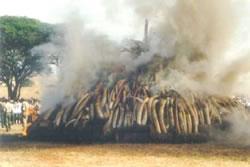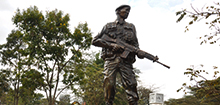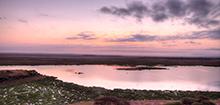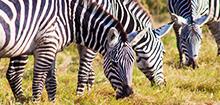
Date Published: 14 Jul, 2009
Kenya Wildlife Service commemorated the 1989 ivory burning ceremony at the Nairobi National Park on Saturday 18, July 1989.
The two decade old past event took a global center stage when an accumulation of 12 tonnes of ivory worth over 1 million USD was torched led by the then President of Kenya H.E Daniel Toroitich Arap Moi.
The July 18, 1989 event marked a significant era in Kenya’s history books for the bold statement that led to the international elephant ivory trade ban. Kenya’s elephant population was at the brink of extinction with numbers dropping from 167, 000 in 1973 to a paltry 16,000 in 1989, marking a state of emergency for the country’s elephants.
The commemoration seeks to remind the world that illegal trade of ivory still remains a threat to African elephants management and conservation and that Kenya remains opposed to lifting the international ivory trade ban.
Currently the elephant population stands at 32,000 thanks to the international trade ban and an efficient wildlife law enforcement unit at the Kenya Wildlife Service. However the decision by CITES (Convention on International Trade in Endangered Species of Wild Fauna and Flora) in the Hague during its fourteenth meeting of the Conference of the Parties (CoP14) in 2007 to partially lift the international trade ban to allow for a one-off sale to China and Japan by four South African countries; Botswana, Namibia, South Africa and Zimbabwe have stimulated poaching across the elephant range and ivory smuggling across the world.
Kenya remains opposed to lifting of the international ivory trade ban particularly the 9-year ivory trade moratorium that was linked to the one off- sale.
About Kenya and CITES
CITES, the United Nations Convention on International Trade in Endangered Species of Wild Fauna and Flora is an international agreement that provides a framework for regulation of international trade in wild fauna and flora through a system of Permits and Certificates
Kenya, United States of America and the International Union for Conservation of Nature (IUCN) drafted the text of the Convention that was first signed at Washington DC in 1973. The Convention entered into force in 1975. Currently it is ratified by 175 member countries whose provisions of the Convention apply.
Kenya has the support of 21 other African countries with elephant populations in the push for continuation of total ban in international ivory trad
The next meeting of the CITES Conference of the Parties (CoP15) will be held in Doha, Qatar in March 2010 and Kenya and her allies will be pushing for the enforcement of agreement reached at the Hague regarding the 9-year ivory trade moratorium allowing the one-off sale.





